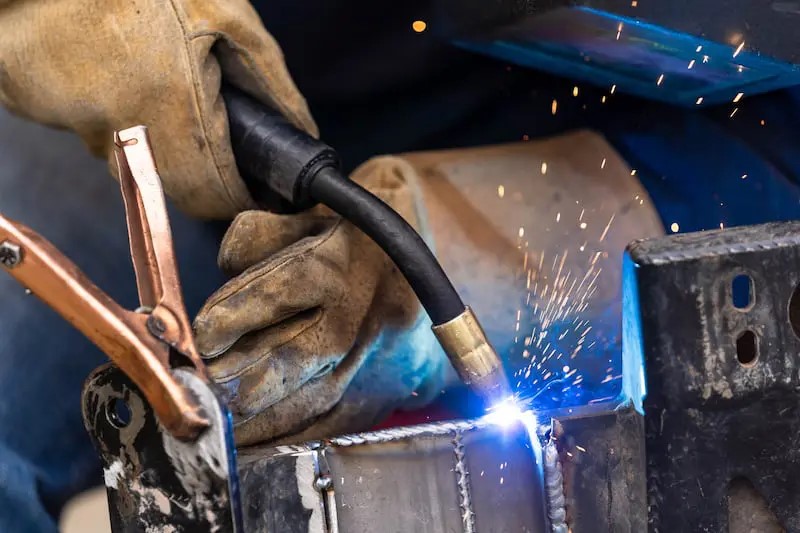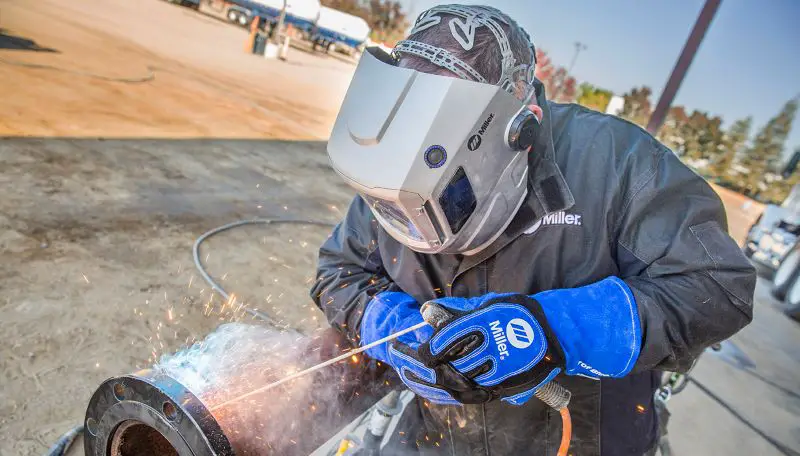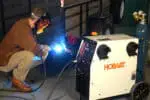Welding is a method used to join two or more metal pieces together. It is a critical aspect of many industries, including construction, manufacturing, and engineering.
There are various types of welding processes available, and each has its own unique advantages and disadvantages.
In this article, we will compare two common welding methods, MIG (Metal Inert Gas) welding, and Stick welding, and evaluate which is better.
MIG welding is better for welding thin materials as it uses a wire electrode that continuously feeds into the weld joint. This creates a cleaner weld with less spatter and reduces the need for post-weld cleanup. MIG welding is also more precise and produces higher-quality welds.
Stick welding, on the other hand, is better for thicker materials and works well in outdoor environments or on dirty, rusty, or painted surfaces. Stick welding can be done with a variety of electrodes and can handle a range of welding positions.
Ultimately, the choice between MIG and stick welding will depend on the materials being welded and the specific needs of the project.
MIG Welding
MIG welding is a popular welding technique that uses a wire electrode to join two pieces of metal together. This process is also known as Gas Metal Arc Welding (GMAW) and is a relatively straightforward method of welding.
In MIG welding, an electric current is passed through a wire that is continuously fed through the welding gun. The wire melts and fuses with the base metal to create a strong bond.
Advantages of MIG Welding
MIG welding is one of the easiest welding methods to learn and is ideal for beginners. Here are some of the benefits of MIG welding:
1. Speed – MIG welding is one of the fastest welding methods available. The wire feed system makes it possible to weld continuously, which can help reduce the overall welding time.
2. Ease of use – MIG welding is a simple welding process that requires little experience to produce high-quality welds.
3. Cleaner welds – MIG welding produces a cleaner weld than Stick welding, with less slag and spatter.
4. Versatility – MIG welding is a versatile welding process that can be used on a wide range of materials, including aluminum, stainless steel, and mild steel.
Disadvantages of MIG Welding
Like any welding process, MIG welding has its drawbacks. Here are some of the disadvantages of MIG welding:
1. Cost – MIG welding can be more expensive than Stick welding, as it requires a constant supply of shielding gas.
2. Weather-dependent – MIG welding requires a controlled environment, as wind and rain can disrupt the shielding gas.
3. Not suitable for thick metals – MIG welding is not ideal for welding thicker metals as the wire feed system struggles to penetrate the metal.
Stick Welding
Stick welding is an arc welding process that uses an electrode to create an arc between the electrode and the base metal.
The electrode is made up of a metal rod coated in flux, which creates a shielding gas to protect the weld from contaminants.
Stick welding is also known as Shielded Metal Arc Welding (SMAW) and is one of the oldest welding methods available.
Advantages of Stick Welding
Stick welding has been used for over 100 years and remains one of the most popular welding methods. Here are some of the advantages of Stick welding:
1. Versatility – Stick welding can be used on a wide range of materials, including carbon steel, cast iron, and stainless steel.
2. Cost-effective – Stick welding is a cost-effective welding method, as it doesn’t require a constant supply of shielding gas.
3. Outdoor use – Stick welding can be used in outdoor environments as the electrode coating creates its shielding gas.
4. Welds thicker metals – Stick welding can weld thicker metals than MIG welding, as the electrode can penetrate more viscous materials.
Disadvantages of Stick Welding
Stick welding may be one of the most popular welding methods, but it also has its downsides. Here are some of the disadvantages of Stick welding:
1. Limited to flat surfaces – Stick welding is not suitable for welding on vertical surfaces or overhead.
2. Low productivity – Stick welding is a slower process than MIG welding, and it can take longer to complete a weld.
3. More difficult to learn – Stick welding requires more experience to produce high-quality welds than MIG welding.
Differences Between MIG and Stick Welding
MIG and stick welding are two of the most popular welding techniques in the industry. Both methods involve using an electric arc to heat and melt metal, but the similarities end there.
MIG and stick welding are different in many ways, including the type of electrode used, the equipment used, and the welding process itself.
1. The Type of Electrode
One of the most significant differences between MIG and stick welding is the type of electrode used. MIG welding uses a wire electrode that is fed continuously through a welding gun.
This electrode is coated in a flux that shields the arc and the molten metal from the atmosphere. The flux also creates a slag layer that covers the weld and must be removed once the weld is cooled.
Stick welding, on the other hand, uses a coated electrode that is manually inserted into the weld pool. This electrode is made of a metal core surrounded by a flux coating.
As the electrode melts, the flux coating creates a gas shield that protects the weld from the atmosphere. The flux coating also creates a slag layer that must be removed once the weld is cooled.
2. The Equipment Used
Another significant difference between MIG and stick welding is the equipment used. MIG welding requires a MIG welder, which consists of a power source, a wire feed system, and a welding gun.
The power source provides the electricity needed to create an arc, while the wire feed system feeds the wire electrode through the welding gun.
Stick welding, on the other hand, requires a stick welder, which consists of a power source and a welding electrode holder.
The power source provides the electricity needed to create an arc, while the electrode holder holds the coated electrode and delivers it to the weld pool.
3. The Welding Process
The welding process itself is another significant difference between MIG and stick welding. MIG welding is a semi-automatic process that is easy to learn and use.
The welding gun is held at a constant distance from the workpiece, and the wire electrode is fed through the gun at a constant rate. The welder only needs to control the movement of the gun and maintain the correct angle.
Stick welding, on the other hand, is a manual process that requires more skill and practice to master.
The coated electrode is manually inserted into the weld pool, and the welder must control the arc length, the speed of the electrode, and the angle of the electrode holder.
Stick welding is often used in situations where a high degree of precision is required.
4. Advantages and Disadvantages
MIG and stick welding has their own set of advantages and disadvantages. MIG welding is a fast and efficient process that is ideal for welding thin materials.
It also produces a cleaner weld with less spatter and no slag to remove. MIG welding can also be automated, which makes it ideal for high-volume production.
However, MIG welding does have some disadvantages. It requires a clean work surface, and it is sensitive to wind and drafts. MIG welding also requires a shielding gas, which can be expensive and difficult to transport.
Stick welding, on the other hand, is a versatile process that can be used in a wide range of applications. It is also an excellent choice for welding thick materials and for welding in challenging environments. Stick welding is also relatively inexpensive, and the equipment is easy to maintain.
However, stick welding also has its drawbacks. It produces more spatter and slag than MIG welding, which requires more clean-up. Stick welding is also slower than MIG welding, and it requires more skill and practice to master.
Wrapping UP
MIG and stick welding are two of the most popular welding techniques in the industry, each with its own set of advantages and disadvantages.
MIG welding is a fast and efficient process that is ideal for welding thin materials, while stick welding is a versatile process.








